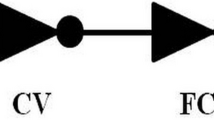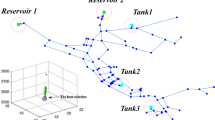Abstract
In this study, Subsystem-Based Pressure Dependent Demand (SPDD) analysis is implemented using the concept of effective supply to eliminate the uncertainties caused by the Head-Outflow Relationship (HOR) in Pressure Dependant Demand (PDD) analysis. This study optimizes the nodal water demands to satisfy the nodal pressure requirement under the abnormal condition defined as the part of the water distribution systems that is closed due to maintenance, rehabilitation, or accidents. The total water supply is optimized and defined as the effective supply, which is the maximum water supply while maintaining the nodal pressure requirements (25 psi) to guarantee the customer’s convenience. A meta-heuristic algorithm, the Harmony Search (HS) algorithm, is applied to optimize the system. To decrease the effect of the HOR uncertainties, an optimization method is proposed in this study using the EPANET model that is widely used for the hydraulic simulation. To evaluate the applicability of the suggested model, Supply Index (SI), Pressure Index (PI), Effective Supply Index (ESI), and Subsystem Importance Index (SII) are also defined and calculated from a real-sized network. This paper firstly tried to perform pressure dependent demand analysis for subsystem without the HOR equation that has been an important issue in water distribution system analysis. The developing method could be a good alternative for the design and maintenance of water distribution systems.
Similar content being viewed by others
References
Ackley, J. R. L., Tanyimboh, T. T., Tahar, B., and Templeman, A. B. (2001). “Head driven analysis of water distribution system.” Water Software Systems: Theory and Applications, Coulbeck, B. and Rance, J. P. (eds.), Vol. 1, pp. 183–192.
Ang, W. H. and Jowitt, P. W. (2006). “Solution for water distribution systems under pressure-deficient conditions.” J. Water Resour. Plann. Manage., Vol. 132, No. 3, pp. 175–182.
Baek, C. W. (2002). Development of optimal decision-making system for rehabilitation of water distribution systems using ReHS, Master’s Thesis, Korea University, Korea.
Baek, C. W. (2007). Development of HSPDA model for analysis of water distribution systems under abnormal operating conditions, PhD Dissertation, Korea University, Korea.
Baek, C. W., Jun, H. D., and Kim, J. H. (2010). “Development of a PDA model for water distribution systems using harmony search algorithm.” KSCE Journal of Civil Engineering, Vol. 14, No. 4, pp. 613–625.
Bentley Systems (2006). WaterGEMS, Bentley Systems Incorporated, Exton, PA.
Bhave, P. R. (1981). “Node flow analysis of water distribution systems.” Transportation Engineering Journal of ASCE, Vol. 107, No. TE4, pp. 457–467.
Carey, M. and Hendrickson, C. (1984). “Bounds on expected performance of networks with links subjected to failure.” Networks, Vol. 14, No. 3, pp. 435–456.
Chandapillai, J. (1991). “Realistic simulation of water distribution system.” J. Transp. Eng., Vol. 117, No. 2, pp. 258–263.
Fujiwara, O. and De Silva, A. (1990). “Algorithm for reliability based optimal design of water networks.” J. Environ. Eng., Vol. 116, No. 3, pp. 575–587.
Gupta, R. and Bhave, P. R. (1996). “Comparison of methods for predicting deficient-network performance.” J. Water Resour. Plann. Manage., Vol. 122, No. 3, pp. 214–217.
Jun, H. (2005). Strategic valve locations in a water distribution system, PhD Dissertation, Department of Civil Engineering, Virginia Polytechnic Institute and State University, Blacksburg, Virginia.
Mays, L. W. (2003). Water supply systems security, McGRAW-HILL.
Ozger, S. S. (2003). A semi-pressure-driven approach to reliability assessment of water distribution network, PhD Dissertation, Department of Civil and Environmental Engineering, Arizona State University, Tempe, Arizona.
Park, H. and Liebman, J. C. (1993). “Reliability-constrained minimum cost design of water distribution nets.” J. Water Resour. Plann. Manage., Vol. 119, No. 1, pp. 83–98.
Rossman, L. A. (2000). EPANET2 users’ manual, Drinking water research division, risk reduction engineering laboratory, Office of Research and Development, U.S. Environmental Protection Agency, Cincinnati.
Salgado-Castro, R. O. (1988). Computer modeling of water supply distribution network using the gradient method, PhD Thesis, Univ. of Newcastle upon Tyne, U.K.
Tanyimboh, T. T. and Tabesh, M. (1997). “Discussion comparison of methods for predicting deficient-network performance.” J. Water Resour. Plann. Manage., Vol. 123, No. 6, pp. 369–370.
Todini, E. (2006). “Towards realistic extended period simulations (EPS) in looped pipe network.” Proc., 8th Annual Int. Symp. on Water Distribution Systems Analysis (CD-ROM), ASCE, Reston, Va.
Todini, E. and Pilati, S. (1988). “A gradient algorithm for the analysis of pipe network.” Computer Applications in Water Supply, Coulbeck, B. and Chu-Hou, O. (eds.), Vol. 1-System Analysis and Simulation, Wiley, London, pp. 1–20.
Udo, A. and Ozawa, T. (2001). “Steady state analysis of pipe networks considering reduction of outflow in the case of low water pressures.” Water Software Systems: Theory and Applications, Coulbeck, B. and Rance, J. P. (eds.), Vol. 1, pp. 173–182.
Wagner, J. M., Shamir, U., and Marks, D. H. (1988). “Water distribution reliability: Simulation methods.” J. Water Resour. Plann. Manage., Vol. 114, No. 3, pp. 276–294.
Walski, T. M. (1993). “Water distribution valve topology for reliability analysis.” Reliability Engineering and System Safety, Vol. 42, No. 1, pp. 21–27.
Wu, Z. Y. (2007). “Discussion on ’solution for water distribution systems under pressure-deficient conditions’ by Ang and Jowitt.” J. Water Resour. Plann. Manage., Vol. 133, No. 6, pp. 567–568.
Wu, Z. Y. and Walski, T. M. (2006). “Pressure dependent hydraulic modeling for water distribution systems under abnormal conditions.” Proc., 5th IWA World Water Congress (CD-ROM).
Wu, Z. Y., Wang, R. H., Walski, T. M., Yang, S. Y., Bowdler, D., and Baggett, C. C. (2009). “Extended global-gradient algorithm for pressure-dependent water distribution analysis.” J. Water Resour. Plann. Manage., Vol. 135, No. 1, pp. 13–22.
Author information
Authors and Affiliations
Corresponding author
Rights and permissions
About this article
Cite this article
Yoo, D.G., Suh, M.Y., Kim, J.H. et al. Subsystem-based pressure dependent demand analysis in water distribution systems using effective supply. KSCE J Civ Eng 16, 457–464 (2012). https://doi.org/10.1007/s12205-012-1448-1
Received:
Revised:
Accepted:
Published:
Issue Date:
DOI: https://doi.org/10.1007/s12205-012-1448-1




